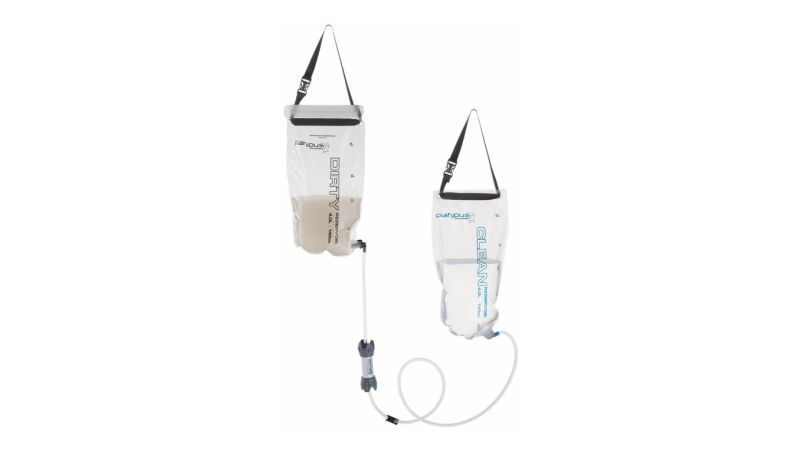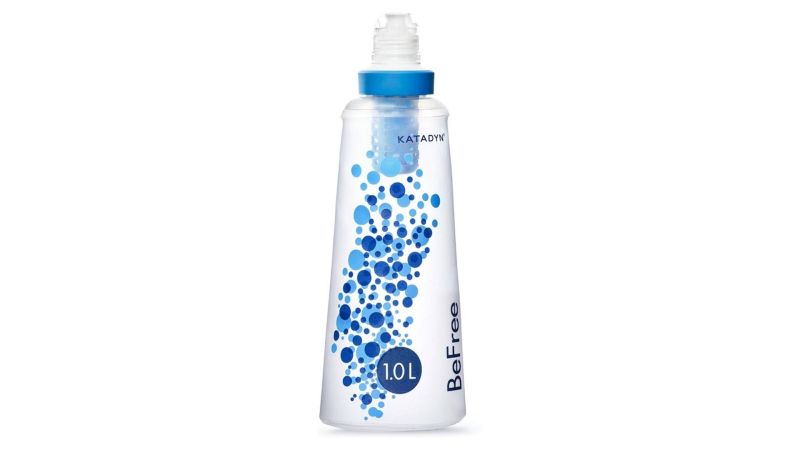We may earn revenue from the products available on this page and participate in affiliate programs.

When traveling through the backcountry, water is life, and knowing where to find water and how to purify or filter water are essential wilderness skills. At 8.34 pounds per gallon, water is also one of the heaviest things to strap on your back, so being able to replenish water along the way lightens your load and extends how far you can travel. In an emergency or survival situation, being able to access safe water could mean the difference between life and death, as humans can go about three weeks without food but only three days without water. Water is life, and you never want to be caught without it.
There are a lot of portable water filters and purifiers on the market, so we reviewed the best backpacking water filters out of all of them to help you make the purchase that’s right for you. Shop smart and stay hydrated — or else.
Best Overall
Platypus GravityWorks
Best Value
Katadyn BeFree Water Filtration System
Best Personal Use
Sawyer Squeeze
Best Virus-Killing System
WAATR CrazyCap
Lightest Water Filter
LifeStraw
Best for International Travel
Grayl Geopress
Why you should trust us
The active-duty and veteran gear reviewers here at Task & Purpose test the products we review at home and in the field. We have years of experience living and working outdoors with the tools we recommend. We don’t get paid by the manufacturers and we have editorial independence. Our editor leaves it to us to recommend, and prints what we write. All of this enables us to provide you, our valued readers, our unvarnished, honest opinions on the recommendations we make.
Types of backpacking water filters
The main difference between water purifiers and filters is the size of the microorganisms they remove. Portable water purification systems generally use boiling methods, chemicals like chlorine or iodine, or UV light to kill pathogenic organisms to include protozoa, bacteria, and viruses. Most purification systems do not filter out suspended solids in the water, so it will turn out clean but occasionally “chunky.” Chemical drops tend to be low-cost options, but not the most effective against some seriously gnarly bacteria. Water filters work by passing dirty water through a filter media to strain out protozoa and bacteria, but do not generally remove viruses. Water from these systems is free of sediment and solids but may contain viruses, so you need to be careful as to where you source your water. These options are more expensive than chemical drops since equipment is required.
Almost all of the backpacking water filters reviewed here meet or exceed EPA water filtration standards. Most filter to 0.1 microns which gets rid of most protozoa and bacteria (but not viruses). Whatever system you choose, we strongly recommend you read this CDC Guide to Drinking Water Treatment and Sanitation for Backcountry & Travel Use.
Boiling water
This is the cheapest and one of the most effective backcountry water purification techniques. Simply fill a pot with water, set it to a rolling boil for at least one minute (per the World Health Organization and Environmental Protection Agency), and then pour the water through a clean bandanna or paper coffee filter into a canteen. The pros are that it’s cheap and is sufficient to kill pathogenic bacteria, protozoa, and viruses. The cons are that it takes a stove, fuel, paper, or cloth filter medium, and lots of time. It also sucks to drink hot water on warm days.
Chemical purifiers
Using iodine or chlorine drops to kill waterborne pathogens is a fairly cheap and straightforward process. One simply adds the requisite dose of chemical purifier to a canteen of water and waits a specified period of time, generally 30 minutes to four hours. The pros of this method is that it is low-cost. The cons are many, as the water usually tastes like chlorine or iodine, is frequently “chunky” since there is no filtration system involved, and you might still get the shits. While chlorine has a low to moderate effectiveness in killing Giardia, it tends to have high effectiveness in killing bacteria and viruses. Neither iodine nor chlorine is effective in killing Cryptosporidium. We recommend using these methods as a backup to main backpacking water filter systems.
Ultraviolet light purifiers
Several manufacturers like WAATR and SteriPen make water purification systems that use ultraviolet light to destroy pathogens to include viruses. Turbid water degrades their effectiveness as harmful microorganisms can hide from the light behind particles in the water. Generally, these systems aren’t great for processing large amounts of water at one time. These systems require batteries or electrical charging, so they are less than ideal for long trips.
Pump filtration systems
These systems are old-school and most backpackers do not use them anymore. One of the advantages is that they typically have siphon hoses which allows for easier access to very shallow water sources, and a rare few remove viruses. The cons are that pumping is a pain in the ass, they tend to be more expensive, and they’re bulky, slow, and heavy. They’re also hard to clean in the field. For this reason, we don’t recommend them for backpacking in most instances.
Hollow fiber filtration systems
Most modern backpacking water filtration systems use some form of a hollow fiber filter tube encased in filter cartridges. These systems work by essentially straining out particles larger than a few microns to include most pathogenic protozoa and bacteria. Almost all do not filter out viruses. Some of these systems rely on you to squeeze a bag containing the water to be filtered through the filter canister, and others are designed so you can simply place or hang the dirty bag above the canister and allow gravity to do the work for you. These filter cartridge systems almost always require backflushing as the filters become clogged with silt, sediment, and other suspended solids. Some, like the Katadyn BeFree, are all-in-one units combining the filter and the reservoir. Others are separate units like the Platypus GravityWorks system.
Key features of backpacking water filters
Performance
Look for filtration systems that filter out particles larger than 0.1 microns and will remove 99.9999 percent of bacteria and protozoa. If viruses are a concern, consider boiling, chemical, or UV purification methods.
Lightweight
When backpacking, you have to carry everything you need on your back. Weight matters: The lighter the load, the farther and faster you’ll travel, and you’ll have a more enjoyable time doing it. You can find many good water filtration systems that weigh less than a pound. Go for the lightest that adequately meets your needs.
Capacity
It’s important to know whether you’ll be using the filtration device just for your own needs or for a group. For yourself, you can get away with a low-capacity device. For groups, multiple people relying on a limited capacity system is a recipe for frustration, which is always amplified when you are tired and thirsty. Most of the filtration systems listed here will produce several liters of water in just a few minutes. If it’s just you, go with the Sawyer Squeeze or Katadyn BeFree. If it’s you plus others, go for the Platypus GravityWorks or the 2L variant of the BeFree.
Speed
Speed of filtration is a concern when you’re on the go. Every break taken to filter water on the trail equates to distance not walked. I prefer the Platypus system, so I tend to plan breaks around water sources so I can rest my body while filtering water. For on-demand, on-the-fly filtration, go with the Sawyer Squeeze or Katadyn BeFree. Strive to be efficient in the backcountry. Wasted energy equals more fatigue. Look for systems that don’t take a long time to produce clean water.
Benefits of backpacking water filters
Health and hydration
When in the backcountry, it’s imperative to minimize risk as you are usually hours if not days from help. Dehydration and heat-related illnesses can lead to disastrous consequences if not anticipated or quickly addressed. The human body can survive for weeks without food, but only days without water, and staying hydrated with clean, safe water is critical in maintaining peak performance.
Packability
Like weight, packability is a major consideration when selecting backpacking equipment like water filtration systems. I prefer to take the least amount of gear that provides me the greatest amount of utility and safety margin. When everything takes up cubic inches in a backpack, I lean in the direction of small, collapsible, and stackable. When deciding between two equally performing systems, choose the smaller and lighter one. All of the filtration systems we reviewed are lightweight and easily stowed in a backpack — and some are smaller, much smaller than others.
Ease of use
Even a Marine could operate the most complicated system we reviewed. Ease of use is critical. When traveling far from home in areas with limited resources, simplicity reigns. Typically, the fewer the number of process steps or moving parts, the simpler the system. The best-designed water filtration equipment is that which you can operate when fatigued, in the dark, or in an emergency where time is of the essence. Just like your drill instructor told ya, K.I.S.S.: Keep it simple, stupid!
Pricing considerations for backpacking water filters
Budget
Low-cost water purification or filtration systems cost about $10 to $29. This price band includes chemical treatments like Potable Aqua tablets, Aquamira water treatment drops, the Lifestraw, and the Sawyer Mini.
Mid-range
You can expect to pay between $30 and $80 for most backpacking water filters and purifiers. Options include the Katadyn BeFree, and Grayl Geopress.
Premium
High-end options cost between $81 and $350 and feature exceptional performance, capacity, and durability, like the Platypus GravityWorks.
How we chose our top picks
All of the backpacking water filtration and purification devices recommended in this review were field-tested by your trusty crew of Task & Purpose gear reviewers. We take our time to get to know each backpacking water filter’s strengths and weaknesses and check out the reviews of other experts just to make sure we’re not missing anything.
FAQs on backpacking water filters
You’ve got questions, Task & Purpose has answers.
Q: What’s the difference between a purifier and a filtration system?
A: Purifiers tend to nuke all pathogens to include viruses, while filtration systems generally remove all bacteria and protozoa larger than 0.1 microns, but not viruses.
Q: Is a gravity or squeeze filter better?
A: It depends. Do you like to take a break while filtering water? Use a gravity system. If you like to get your water and go, use a squeeze system.
Q: Why do I need to protect hollow tube filter cartridges from freezing?
A: When water freezes, it expands and can damage the tubes. When the tubes get damaged, they don’t filter well and could let pathogens get through. When pathogens get through, you get the shits or worse.








